1990년대에 중국산시성에 있는 시안지역을 탐방했었다.
지금도 기억에 생생한것은, 지하에서 발굴된지 얼마 안된, 실제 사람크기와 똑같은 Terracotta Army가 묻혀있는 Pit를 일반에게 공개하여, 운좋게 탐방하게 됐었다. 당시 Tour Guide의 설명은 Pit하나만을 개방된것을 설명하면서, 눈 비 바람으로 부터 보호하기위한 가건물은 겨우 지붕만 있었던 것으로 기억된다.
1970년대초에 이지역에 심한 가뭄이 덮쳐 농부들은 모자란 농업용수를 지하로 부터 끌어 올리기위해 지하로 땅을 파 내려갔는데, 우연히 Terracotta Army를 발견하면서, 고고학자로 정평이 있던, Zhao Kangmin씨가 현지에서, 오늘 우리가 볼수 있는 거대한 Pit를 발견하게 됐다고 한다.
20세기에 인류문화의 최고라고 할수있는 Terracotta Army를 발견했던, 고고학자가 81세로 세상을 떠났다는 뉴스가 전세계로 타전된것을 보면서, 옛날 진시황제가 죽음을 앞두었을때의 심정은 어땠을까?라는 생각을 해봤다.
이연락을 받은 Zhao씨는 진시황제의 동상에서 떨어져 나온 조각들임을 짐작할수 있었다고한다. 이보다 몇주앞서 구리로 만든 화살들을 팔고있던 농부들은 지금 즉시 그 판매 행위를 금하라는 당국의 연락을 받았다. 발견된 조각들은 수집되여 추럭에 싣고 박물관으로 운반했다. Zhao씨는 정성들여 조각들을 마추기 시작했었다. 아주 적은 조각들은 손톱크기정도였었다.
3일동안 조각들을 맞춘다음에, 두개의 토기로된 병사들이 자기앞에 우뚝선있는것을 알게됐다. 키가 자그만치 1.78미터나 됐었다. 그러나 Zhao씨는 이러한 믿기지 않은 동상앞에서 부표처럼 부동자세로 한동안 서있었지만, 동시에 무섭기도 했다고 한다. 1974년 당시 중국에서는 모택동의 문화혁명이 막을 내리고 있는 때였었다. 문화혁명당시 젊은 홍위병들은 옛날것들은 무조건 다 때려 부시고, 사회를 깨끗하게 "정화"시켜야 된다는 사상으로 꽉차 있었시절이었었다.
3일동안 조각들을 맞춘다음에, 두개의 토기로된 병사들이 자기앞에 우뚝선있는것을 알게됐다. 키가 자그만치 1.78미터나 됐었다. 그러나 Zhao씨는 이러한 믿기지 않은 동상앞에서 부표처럼 부동자세로 한동안 서있었지만, 동시에 무섭기도 했다고 한다. 1974년 당시 중국에서는 모택동의 문화혁명이 막을 내리고 있는 때였었다. 문화혁명당시 젊은 홍위병들은 옛날것들은 무조건 다 때려 부시고, 사회를 깨끗하게 "정화"시켜야 된다는 사상으로 꽉차 있었시절이었었다.
Terracotta Army는 중국대륙 최초인 진시황제의 군사들을 묘사한 조각품의 집합체라고 할수있겠다. 진시황제와 함께 매장시킨 일종의 장례행열을 묘사했던 것으로 이해되며, 기원전 210년에 진시황제의 사후삶이 황제로서 계속될수 있도록 보호하기위한 목적에서 만들었다는 기록이다.
기록에 의하면, 병정은 8,000명, 말 520마리가 끄는 전투용마차 130대, 포운반용 말150마리가 진시황제의 사당이 있는곳에서 멀지 않은곳에 매장되여 있다.
여기서 나는 조금 앞뒤가 안맞는것 같은 생각을 해보게 된다. 진시황제의 능은 Terracotta Army가 발견된 시기보다 조금 앞선 1960년대 중반에 발견됐던것으로 알고 있는데, 진시황의 능은 Terracotta병정들과는 별도로, 마치 Mount처럼 크게만들어져 있었고, 현재까지도 내부는 발굴을 중국측에서 허가하지 않아, 레이져로 능의 내부를 탐사하여, 실제 크기의 1/350로 축소하여 능의 옆에 Replica를 만들어 전시하고 있는 내부를 탐방했던 기억이 있다. 능안에는 수많은 궁녀들을 포함한 시냇물까지 흐르고 있었는데, 마치 마을을 보는것 같은 카다란 능이었었다.
신라시대 수도였던 경주에 가면, 신라시대의 여러왕들의 능이 있는것을 보았었는데, 크기를 비교해 본다면, 간장종지와 간장을 보관하는, 어른들 가슴까지 닿는 거대한 간장 항아리 정도로 상상해 보면 그크기가 비교될것 같지 않을까?
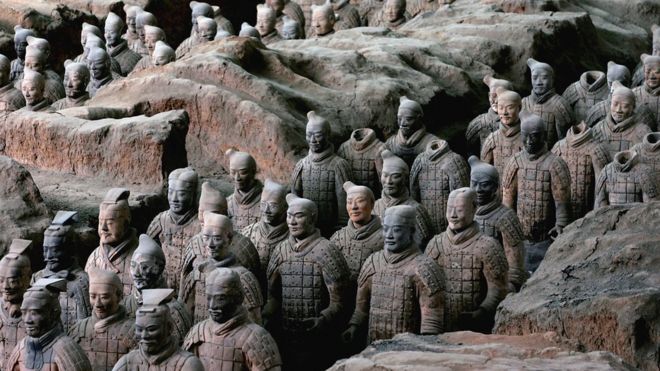 GETTY IMAGES
GETTY IMAGESBBC의 뉴스 보도를 아래에 옮겨 놓았다.
When archaeologist Zhao Kangmin picked up the phone in April 1974, all he was told was that a group of farmers digging a well nearby had found some relics.
Desperate for water amid a drought, the farmers had been digging about a metre down when they struck hard red earth. Underneath, they had found life-size pottery heads and several bronze arrowheads.
It could be an important find, Zhao's boss said, so he should go and have a look as soon as possible.
A local farmer-turned-museum curator in China's central Shaanxi province, Zhao - who died on 16 May at the age of 81 - had an inkling of what he might find. He knew figures had in the past been dug out of the earth in the area near the city of Xian, home to orchards of persimmon and pomegranate trees, and not far from the tomb of China's first emperor, Qin Shi Huang.
A decade earlier, he had personally uncovered three kneeling crossbowmen. But he had never been certain that they dated back to the rule of the emperor - who unified the Chinese nation for the first time under the short-lived Qin dynasty (221-206 BC).
But what Zhao was about to find would surpass anything he could have imagined. The farmers, it would turn out, had stumbled upon one of the most stunning archaeological finds of the 20th Century: a terracotta army estimated at 8,000-strong, crafted on an industrial scale 2,200 years earlier to defend the emperor in the afterlife. A ghost army, complete with horses and chariots, hidden underground and never meant to be seen by the living.
Zhao headed to the location of the find with a colleague. "Because we were so excited, we rode on our bicycles so fast it felt as if we were flying," he would later write in a 2014 essay. As he arrived, Zhao told the British historian John Man: "I saw seven or eight pieces - bits of legs, arms and two heads - lying near the well, along with some bricks."
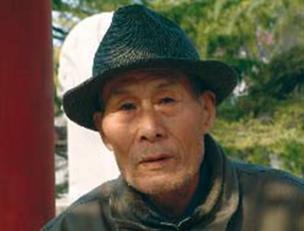 JOHN MAN
JOHN MAN
He said he immediately realised these were likely the remnants of Qin-era statues. The farmers - who had made the find weeks earlier and already sold some of the bronze arrowheads for scrap - were told to stop their work immediately. The relics were collected and brought to the museum on the back of trucks. Zhao began laboriously putting the fragments together. Some, he later said, were the size of a fingernail.
Finally, after three days of work, two imposing terracotta warriors stood before him - each 1.78m tall. But while Zhao was buoyed by this incredible discovery, he was also nervous. China in 1974 was in the closing stages of Chairman Mao's Cultural Revolution - under which the fearsome Red Guards sought to destroy old traditions and ways of thinking to "purify" society.
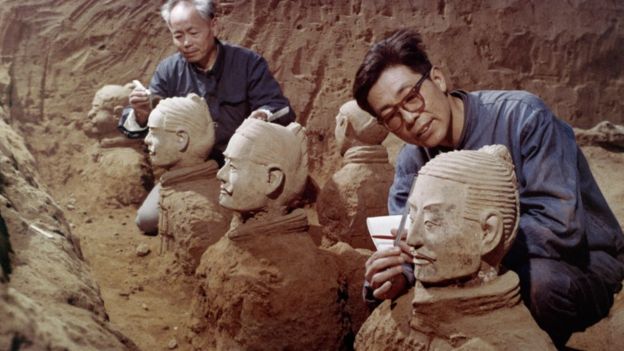 DANIELE DAROLLE
DANIELE DAROLLE
Zhao, as Man recounts in his book The Terracotta Army, had personally been subject to a "self-criticism" session in the late 1960s, as a person "involved with old things". So now although the worst excesses of that period were over, Zhao was worried what might become of the statues.
He "decided to keep it secret", restore the artefacts, "and then wait for the right opportunity to report it".
But those plans would be scuppered by a young journalist from state news agency Xinhua, who was visiting the area when he came across the statues.
"He asked: 'This is such a huge discovery. Why aren't you reporting it?'" Zhao wrote.
To which the archaeologist replied: "Even I don't know how to make sense of this. How could I report it?"
Ignoring his pleas, the journalist publicised the find, and word made its way to the very top of the Communist Party leadership. Zhao's fears that the relics could be smashed for political reasons, however, proved unfounded.
The authorities in Beijing decided to excavate the site and within a few months more than 500 warriors had been uncovered.
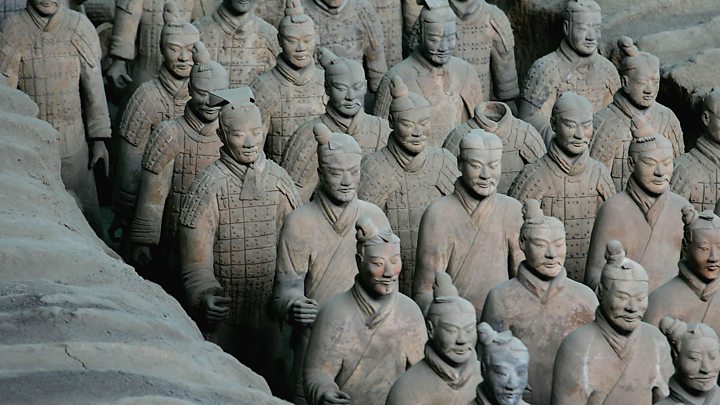
As the work continued, the extraordinary scale of what the First Emperor - a ruthless man who defeated six warring states to unite China under an imperial system that continued until 1912 - had commissioned became clear. He is said to have ordered the subterranean project - which in total covers some 56 sq km - soon after ascending to the throne at 13 years old.
The thousands of warriors were placed in battle formation, ready to defend their emperor from whatever might await in the afterlife. The workmanship was detailed, with dozens of different types of heads, and in the burial pits were 100 chariots and tens of thousands of bronze weapons.
The actual tomb of Emperor Qin Shi Huang remains sealed. There could be thousands of precious artefacts inside but the risks of opening the tomb, and irreparably damaging what may lie inside, means the Chinese government has held off so far.
In 1975, a year after the excavations began, a decision was made to open a museum at the site. And as digging continued in the coming years, word spread about the scale of what had been found. Foreign dignitaries and some tourists began to visit. Zhao was there and lapping up the attention, says Prof Dame Jessica Rawson of the University of Oxford, who specialises in Chinese art and archaeology and visited the sites in the early 1980s.
"By the time I met him everyone was showing him great respect and he was very much sort of enjoying the esteem associated with the terracotta warriors," she said.
But the professor added: "I'm not sure how he or the Chinese authorities viewed it at the time. They were probably not expecting the acclaim and success that it has later enjoyed."
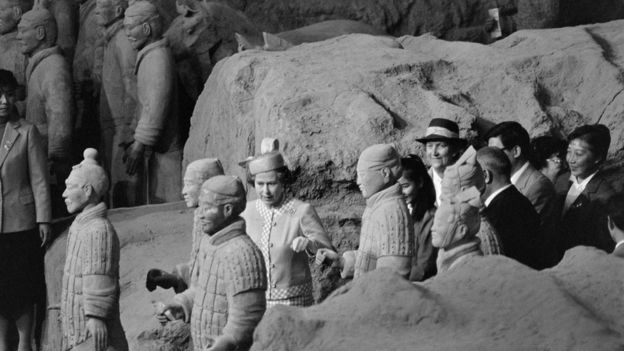 AFP
AFP
It did take some years for the site to receive widespread global recognition. It was given Unesco World Heritage status in 1987, with the UN cultural body describing the warriors as "masterpieces of realism".
Today, the site is widely recognised as a Chinese national treasure. But there is a sense that Zhao's personal role in the discovery was never fully recognised. He is by no means well-known in China.
Read about other notable lives
- The teacher who saved hundreds of lives
- The sergeant in the only all-female, all-black WW2 unit
- The 9/11 rescuers who died a day apart, 17 years on
- The disgraced rugby star who disappeared
Instead, one of the farmers - Yang Zhifa, whose shovel is said to have unearthed the first artefact - is described to visiting tourists as the person who discovered the warriors.
For years he sat in the Museum of the Terracotta Warriors and Horses, quietly and unsmilingly signing books. It was he, not Zhao, who travelled abroad to tell his story. In 1998, when then US President Bill Clinton visited, it was Yang who shook his hand.
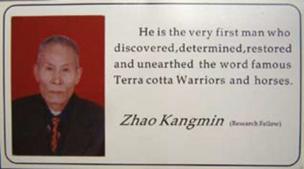 JOHN MAN
JOHN MAN
A few years ago he admitted that he didn't go and see the restored army until 1995, when the museum gift shop manager asked him to sign books.
"He said he would pay me 300 yuan a month. I thought 'that's not bad', so I came," he told the China Daily. Three other farmers would later join him, and their pay was tripled. But all complained they were never rewarded properly for their find, and in fact had their land seized to make way for the museum.
Three of the original group of seven farmers died in terrible circumstances.One hanged himself in 1997, and two others died in their early 50s, penniless and unable to pay for medical care, according to the South China Morning Post.
A local guide who brings tourists to see the warriors, Liu Guoyang, had not even heard of Zhao Kangmin. But he said imposters posed for visitors, pretending to be Yang Zhifa or one of the other farmers.
 AFP
AFP
Zhao was furious when, in 2004, the four surviving farmers officially asked to be registered as the men who had discovered the warriors. They didn't receive a response.
"What they want is money," Zhao told the China Daily. "Seeing doesn't mean discovering. The farmers saw the terracotta fragments, but they didn't know they were cultural relics, and they even broke them.
"It was me who stopped the damage, collected the fragments and reconstructed the first terracotta warrior," he said. If he hadn't have turned up, he told John Man, "it would have been a disaster".
Wu Yongqi, head of the Museum of the Teracotta Warriors from 1998-2007, agreed that Zhao, who he described as a simple but kind man, was the person who "recognised the significance and true value of those warriors".
Without him, Mr Wu said, the extraordinary find might have been delayed for years.
Unlike the farmers, who signed books for hordes of tourists at the main warriors' museum, Zhao remained at the much smaller Lintong county museum. Even in his final years, he could be found sitting next to some warriors he had restored, wearing a trilby hat and chatting to curious visitors.
Although he never achieved fame or fortune, Zhao seemed content with the recognition he did receive - proudly saying that during the initial excavation an envoy from Beijing had told him that he had "made a very big contribution to the country". In 1990, he was personally acknowledged by the State Council and given a special pension. He is survived by a wife and two sons.
Zhao's view of his own position in Chinese history - no matter what others might say - was clear. At the Lintong museum, he would sign postcards and books for tourists with an extravagant description: "Zhao Kangmin, the first discoverer, restorer, appreciator, name-giver and excavator of the terracotta warriors."
Additional reporting by Yashan Zhao, BBC Chinese
http://www.bbc.co.uk/news/world-asia-china-44244493


No comments:
Post a Comment